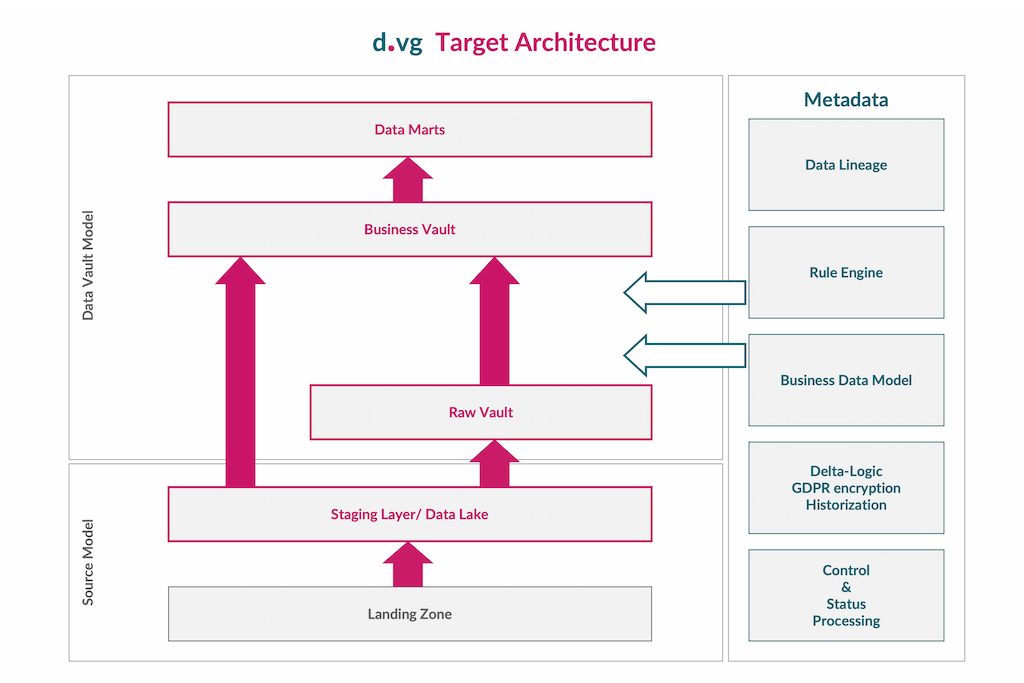
What if data catalog, data governance and data warehouse automation could be done in one go?
The magic triple can now be achieved very easily and effortlessly: with the
d.vg - dataspot. vault generator
Whether it concerns data provision for data lakes and analytical platforms, the provision of harmonized and integrated source data in the data warehouse or the implementation of data mesh implemented across various data domains: target data structures can be modeled in dataspot. and linked to the imported source data structures with minimal effort. The d.vg creates the target model, generates the import jobs and takes care of the loading fully automatically - all at the push of a button with data lineage out-of-the-box, technical historization and GPDR encryption.


When data is required for analyses and analytical models, speed is essential. Often, data scientists resort to pulling files and data sets onto individual platforms themselves to avoid having to wait. Once the data is understood after the initial analysis, this knowledge is usually lost. The data products created reach their target group immediately, but reusability is neglected.
With d.vg, this is a thing of the past, as data structures are automatically created, completed, and stored as metadata on the target platform at the push of a button. The knowledge gained can thus be documented at the same time. The resulting data products can then be created as metadata in the Data Product Catalog with just a few clicks, described and made available to all target groups. In addition, data lineage information is made available with no additional effort. This not only ensures data governance, but also ensures that the data is understood and used.
An integrated and harmonized view of corporate data is the basis for any reliable usage of data by internal and external data consumers. The translation work between data in the source systems and a business-centered view, which is comprehensive and understood by all, is done by capturing the necessary mappings directly as metadata in dataspot.
The required logic required can be created in dataspot. by subject matter experts themselves, since dataspot. is designed for precisely these experts. The descriptions in the business data model thus provide business transparency for all those who want to obtain data from the data warehouse. Data products derived from the business data model in dataspot. automatically receive their data lineage. Data quality as well as data responsibilities can also be stored in one place in dataspot.
Once business data is defined in the business data model and mappings are defined, the implementation effort for data drops to 0 - the d.vg takes over the generation of data structures in the data warehouse, as well as the regular import of data and its transformation. Programming services such as delta processing, historization and GPDR encryption are already included, the target data model is automatically generated as a data vault.
Data Mesh also requires a harmonized, functional company-wide view of the data: clearly separated into the data domains of the individual data owners which form the framework for all business objects in the business data model, while maintaining an integrated overall view. The mappings to the operational source data are created directly in the business data model - the d.vg generates the data structures on the target platform automatically and imports the delivered data regularly - historization and GPDR encryption included.
Data products in dataspot. are designed by simple selection of data from the business data model, for target groups both inside and outside the data domain, and can thus be implemented very quickly. The resulting data lineage and the descriptions in the domain data model ensure an optimal understanding of the data products by the data users - this is our understanding of "Data as a Product".
dataspot. is an innovative company with offices in Vienna, Linz, Basel, Zurich and Berlin, which aims to help its customers realize the value of their company-wide data from a professional perspective.